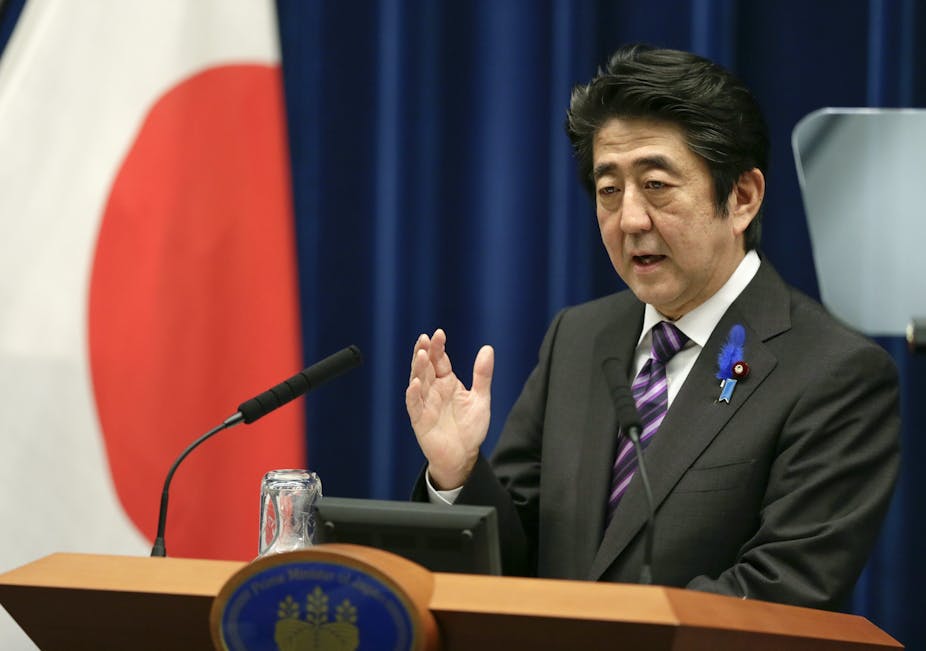Japanese prime minister Shinzo Abe will today address a joint sitting of the Australian parliament as part of his tour of Oceania. This rare honour comes in the wake of his cabinet’s controversial decision last week to reinterpret the pacifist Article 9 clause of Japan’s Constitution. This will allow the Japanese Self-Defence Forces (JSDF) to engage in “collective self-defence” with friendly states.
Australia is set to gain shared access to Japanese “stealth” submarine technology as part of a defence technology sharing agreement due to be signed along with the Japan-Australia Economic Partnership Agreement during Abe’s Australian visit. Abe is also being granted the rare privilege of attending a meeting of cabinet’s National Security Committee.
In its unquestioning embrace of Abe’s more assertive and nationalistic defence policy, the Abbott government risks drawing Australia deeper into a US-led geopolitical containment of China, instead of pursuing more active diplomacy to resolve the worsening tensions between China and its neighbours.
Closer Australian-Japanese defence ties could endanger Australia’s relationship with China, placing the conclusion of a free trade agreement in further jeopardy.
The constitutional reinterpretation
Japan’s defence policy shift is supposedly limited to a range of restricted scenarios, such as defending allied warships under attack near Japanese waters, intercepting hostile ships and missiles, minesweeping, protecting civilians in peacekeeping operations and other “grey zone” scenarios. Abe has sought to reassure the public that despite the new constitutional interpretation, Japan will not engage in overseas wars such as the 2003 invasion of Iraq.
The cabinet decision still requires a parliamentary debate and subsequent bills being passed in the Diet, where the ruling conservative Liberal Democratic Party (LDP) holds a comfortable majority with its ruling coalition partner, the New Komeito Party. Up to 18 laws and treaties will need to be updated to make the changes legally effective.
However, majority public opinion remains opposed to the change, as marked by large public demonstrations. Approval ratings for Abe’s cabinet have fallen to their lowest levels since the LDP came to office in 2012.
Lawyers and academics in Japan are concerned this shift creates a dangerous precedent. The government of the day has chosen to reinterpret the constitution as it sees fit, rather than first put it to a vote in the Diet and then a national referendum of the electorate, which is required for any constitutional alteration. Since being drafted in 1947, Japan’s US-designed constitution has never been amended.
Critics of the reinterpretation also claim that it is unnecessary and provocative. The JSDF is already one of the strongest armed forces in the Pacific It remains highly capable of defending Japanese territory even under Article 9 restrictions.
Japan’s defences are backed up by a large US military presence under the US-Japan Security Treaty. This treaty’s importance was underlined by US president Barack Obama in the Senkaku Islands dispute with China during his visit to Japan in April.
The JSDF has also participated in United Nations peacekeeping operations since the 1990s and in a controversial “non-combat” deployment to Iraq between 2004 and 2006. This demonstrates that Japan is already capable of contributing to international peace and security without having to reinterpret Article 9.
The US has long pushed for reinterpretation of Article 9. The move complements the “pivot” of US maritime forces towards the Pacific. The change will further assist an update to the status of Japan’s defence co-operation with the US, which is due by the end of the year.
And in no small coincidence, on the day of the cabinet decision, JSDF members from Japan’s new amphibious warfare unit joined US-led RIMPAC military exercises held in Hawaii. China also participated in the exercises.

Regional response
Japan’s constitutional reinterpretation has also been welcomed by the Philippines, which is in territorial dispute with China in the South China Sea. Japan’s more active defence posture will involve increasing security-related Overseas Development Aid to various ASEAN states, particularly the Philippines and Vietnam, as well as easing restrictions on defence-related exports.
Abe has also increased security ties with India, as well as trade and investment. On returning to office as prime minster, Abe re-floated the idea of a quadrilateral security arrangement between Japan, the US, India and Australia, which he termed the “Security Diamond”.
However, it seems unlikely that such a structure will come about any time soon, given India’s ambiguous relationship with its neighbour China. Despite both sides desiring closer trade and investment ties, India has territorial disputes with China as part of an increasing strategic rivalry in the Indian Ocean.
China responded angrily to Japan’s policy shift. South Korea is also unhappy with the decision.
Ironically, reaction from traditionally hostile North Korea has been muted. Negotiations to resolve the issue of Japanese abducted by North Korea more than 30 years ago are ongoing. Japan is now easing sanctions against the isolated regime.
Japan’s constitutional shift, promoted by Abe as “proactive Pacifism” and aimed at improving peace and security for Japan and the region, may instead provoke intensified hegemonic confrontation with China.
Further reading: Japan and Australia join forces in Asia’s Brave New World

